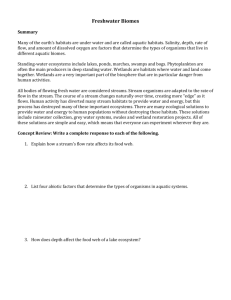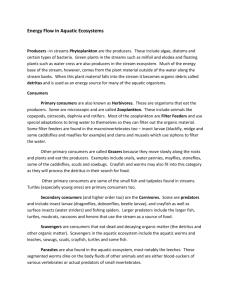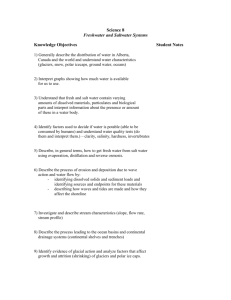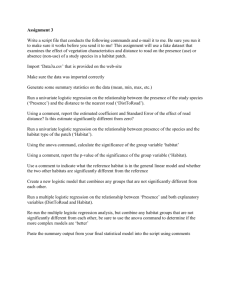15A NCAC 02K .0502 REQUIRED MINIMUM FLOW FOR DAMS
advertisement
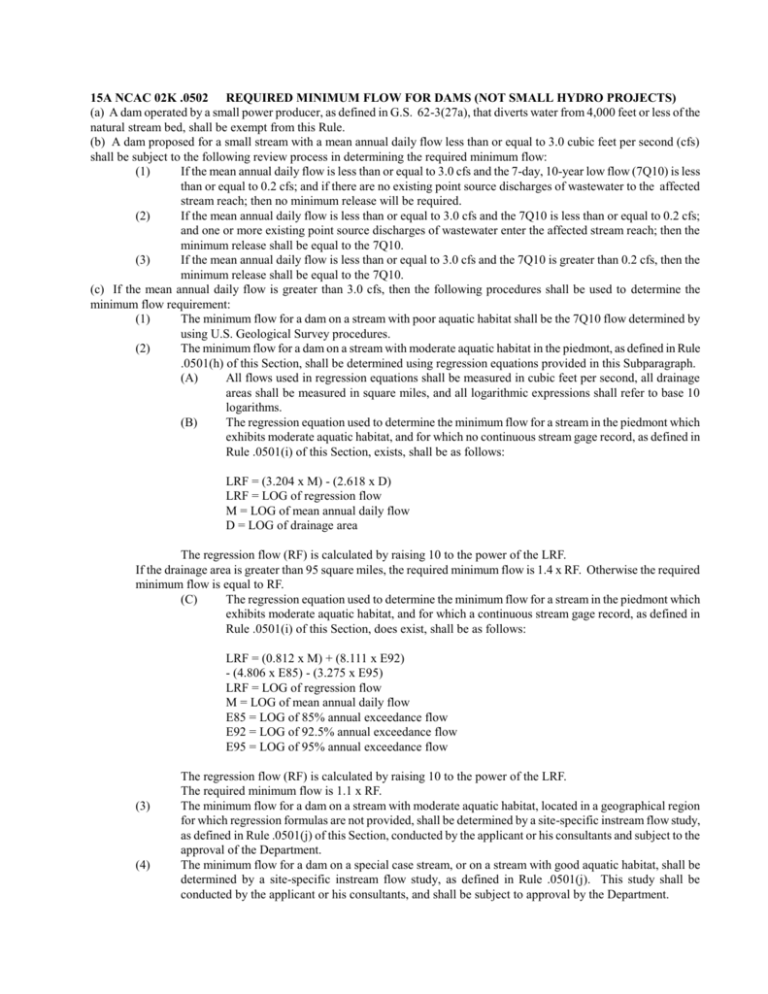
15A NCAC 02K .0502 REQUIRED MINIMUM FLOW FOR DAMS (NOT SMALL HYDRO PROJECTS) (a) A dam operated by a small power producer, as defined in G.S. 62-3(27a), that diverts water from 4,000 feet or less of the natural stream bed, shall be exempt from this Rule. (b) A dam proposed for a small stream with a mean annual daily flow less than or equal to 3.0 cubic feet per second (cfs) shall be subject to the following review process in determining the required minimum flow: (1) If the mean annual daily flow is less than or equal to 3.0 cfs and the 7-day, 10-year low flow (7Q10) is less than or equal to 0.2 cfs; and if there are no existing point source discharges of wastewater to the affected stream reach; then no minimum release will be required. (2) If the mean annual daily flow is less than or equal to 3.0 cfs and the 7Q10 is less than or equal to 0.2 cfs; and one or more existing point source discharges of wastewater enter the affected stream reach; then the minimum release shall be equal to the 7Q10. (3) If the mean annual daily flow is less than or equal to 3.0 cfs and the 7Q10 is greater than 0.2 cfs, then the minimum release shall be equal to the 7Q10. (c) If the mean annual daily flow is greater than 3.0 cfs, then the following procedures shall be used to determine the minimum flow requirement: (1) The minimum flow for a dam on a stream with poor aquatic habitat shall be the 7Q10 flow determined by using U.S. Geological Survey procedures. (2) The minimum flow for a dam on a stream with moderate aquatic habitat in the piedmont, as defined in Rule .0501(h) of this Section, shall be determined using regression equations provided in this Subparagraph. (A) All flows used in regression equations shall be measured in cubic feet per second, all drainage areas shall be measured in square miles, and all logarithmic expressions shall refer to base 10 logarithms. (B) The regression equation used to determine the minimum flow for a stream in the piedmont which exhibits moderate aquatic habitat, and for which no continuous stream gage record, as defined in Rule .0501(i) of this Section, exists, shall be as follows: LRF = (3.204 x M) - (2.618 x D) LRF = LOG of regression flow M = LOG of mean annual daily flow D = LOG of drainage area The regression flow (RF) is calculated by raising 10 to the power of the LRF. If the drainage area is greater than 95 square miles, the required minimum flow is 1.4 x RF. Otherwise the required minimum flow is equal to RF. (C) The regression equation used to determine the minimum flow for a stream in the piedmont which exhibits moderate aquatic habitat, and for which a continuous stream gage record, as defined in Rule .0501(i) of this Section, does exist, shall be as follows: LRF = (0.812 x M) + (8.111 x E92) - (4.806 x E85) - (3.275 x E95) LRF = LOG of regression flow M = LOG of mean annual daily flow E85 = LOG of 85% annual exceedance flow E92 = LOG of 92.5% annual exceedance flow E95 = LOG of 95% annual exceedance flow (3) (4) The regression flow (RF) is calculated by raising 10 to the power of the LRF. The required minimum flow is 1.1 x RF. The minimum flow for a dam on a stream with moderate aquatic habitat, located in a geographical region for which regression formulas are not provided, shall be determined by a site-specific instream flow study, as defined in Rule .0501(j) of this Section, conducted by the applicant or his consultants and subject to the approval of the Department. The minimum flow for a dam on a special case stream, or on a stream with good aquatic habitat, shall be determined by a site-specific instream flow study, as defined in Rule .0501(j). This study shall be conducted by the applicant or his consultants, and shall be subject to approval by the Department. (5) (6) If the applicant or owner disputes the minimum flow determined by the procedures described in Subparagraphs (c)(1) or (c)(2) of this Rule for streams with poor or moderate aquatic habitat, he may undertake a site-specific field study, as defined in Rule .0501(j) of this Section, subject to the review and approval of the Department. The final minimum release required will not exceed the amount determined by the procedures described in this Rule. The minimum release schedule for a water supply reservoir shall include provisions for reductions in the minimum flow which coincide with reductions in the usable water supply storage remaining in the impoundment and with reductions in the amount of water withdrawn from the reservoir. (A) This system of tiered releases shall apply to new water supply reservoirs and any existing water supply reservoirs for which the minimum release is revised. (B) The exact percentage of storage which triggers reductions in minimum flow will depend on several site-specific factors, including, but not limited to: (i) size of the reservoir; (ii) rate of the water supply demand; (iii) hydrologic characteristics of the impounded stream; and (iv) the impoundment levels which result in local efforts to reduce water usage through conservation measures. (C) At least three levels of minimum releases shall be included in the release schedule for a water supply reservoir. (D) When usable water supply storage has been reduced to a level which triggers the first reduction in minimum flow, then the average daily water withdrawal shall be reduced by at least 10 percent from the average daily withdrawal for the 60 day period immediately prior to the first reduction in the minimum flow. The water supply operator shall accomplish this reduction in withdrawal within two weeks of the reduction in the minimum release. (E) When usable water supply storage has been reduced to a level which triggers the second reduction in minimum flow, then the average daily water withdrawal shall be reduced by at least 20 percent from the average daily withdrawal for the 60 day period immediately prior to the first reduction in the minimum flow. The water supply operator shall accomplish this further reduction in withdrawal within two weeks of the second reduction in the minimum release. (F) The water system operator shall document reduction in water withdrawals by submitting reports of daily water withdrawals to the Department. These shall be submitted every two weeks for as long as the minimum release is reduced below the amount normally required. (G) An example is shown in the table below. (Note that the percentages of water supply storage which trigger the changes in minimum release are site-specific for this example and may vary according to the factors described in Part (B) of this Paragraph.) REMAINING USABLE WATER LEVEL SUPPLY STORAGE 1 2 3 between 70% and 100% between 40% and 70% below 40% MINIMUM RELEASE A B C WATER USE REDUCTION ---10% 20% A = normal minimum release determined by a field study, regression equation, or use of the 7Q10 B = intermediate reduction in minimum release C = low minimum release equal to no more than the 7Q10 (7) An existing dam which was built subject to review under the National or the State Environmental Policy Acts, and for which a minimum release has been established, will not have its minimum release changed under this Rule. However, the Department may review and adjust the minimum flow released by any other existing dam if there is evidence of any of the following conditions downstream of that dam: (A) water quality standards not being maintained; (B) water quality classifications which are being only partially supported or not being supported; or (C) aquatic habitat not being maintained. (8) (9) History Note: If the minimum release required from an existing water supply reservoir is reviewed by the Department, any increase in minimum flow will be determined on a case-by-case basis in consideration of the following factors, including, but not limited to: (A) availability of water to meet existing demands; (B) rate of growth in water demand; (C) planned development of alternative sources of water supply; (D) structural difficulties; (E) capital costs; and (F) anticipated improvements in water quality and aquatic habitat in the affected reach resulting from the proposed change in minimum flow. The change in minimum release shall be set no higher than an amount which would reduce the water supply safe yield, as determined by standard accepted engineering practices, by more than 10 percent. If a new minimum release requirement from an existing water supply reservoir is being delayed until a new source of water supply is developed, then this delay shall not exceed a period of five years from the written notification that a new minimum release will be required. This period may be extended by approval of the Environmental Management Commission in consideration of the following factors: (A) delays in developing a new water supply source; (B) changes in water quality and aquatic habitat in the affected reach; or (C) availability of water to meet existing demands. Authority G.S. 143-215.24; 143-215.25; 143-215.31; 143-215.32; 143-215.33; 143-215.36; Eff. December 1, 1994; Amended Eff. April 1, 1995.

